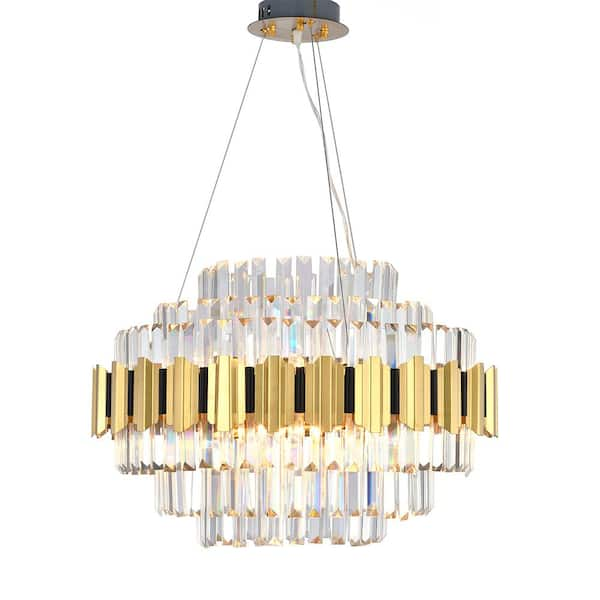
For centuries, chandeliers with crystal have held a place of prestige in grand halls and opulent spaces. These shimmering fixtures transcend their purely functional purpose, casting a spellbinding ambiance and serving as a focal point of awe-inspiring beauty. But the story of crystal chandeliers reaches far beyond their dazzling presence. Delving into their history unveils a fascinating journey of innovation, craftsmanship, and the enduring allure of light.
From Ancient Flames to Faceted Brilliance: A Historical Spark
The earliest ancestors of the crystal chandelier can be traced back to ancient civilizations. Open fires provided illumination in grand spaces, often suspended from the ceiling by chains or hooks. The Romans later developed intricate oil lamps, some crafted from elaborately decorated glass, offering a glimpse into the fascination with light as an art form.
The true birth of the chandelier, however, is attributed to medieval Europe. Candles, the primary source of light at the time, were arranged on branching metal structures, creating the first recognizable chandelier forms. These early fixtures were often crafted from iron or bronze, their weight necessitating strong support beams in grand halls and castles.
The turning point arrived with the discovery of rock crystal in the 15th and 16th centuries. This natural quartz, prized for its clarity and brilliance, became a coveted material for crafting decorative objects. Artisans began incorporating cut crystal prisms into chandelier designs. As light passed through these multifaceted crystals, it refracted and dispersed into a rainbow spectrum, showering the room with a captivating play of light and color. This marked the beginning of the era of the crystal chandelier, forever altering the perception of these fixtures from purely functional to breathtakingly decorative.
A Flourishing Art Form: The Evolution of Crystal Chandeliers
The 17th and 18th centuries witnessed a flourishing of chandelier design. The discovery of new glassmaking techniques, particularly the development of high-quality lead crystal in Bohemia (present-day Czech Republic), fueled a surge in chandelier production. Bohemian artisans became renowned for their exquisite craftsmanship, creating chandeliers with intricate crystal cuts, cascading tiers, and a dazzling array of shapes and sizes.
These chandeliers became a status symbol, gracing the grand halls of palaces, opera houses, and the residences of the wealthy elite. The intricate designs reflected the artistic movements of the time, with Baroque chandeliers featuring bold, dramatic forms and Rococo styles showcasing delicate floral motifs and playful asymmetry.
The invention of the cut-glass technique in the 18th century further revolutionized chandelier design. This method allowed for the creation of even more intricate and light-catching facets, maximizing the brilliance and prismatic effects of the crystals. The era also saw the introduction of new materials like bronze and ormolu (a high-quality gilt brass) for the chandelier’s framework, adding to the overall grandeur and opulence.
Beyond Illumination: The Enduring Magic of Crystal Chandeliers
The allure of crystal chandeliers extends far beyond their ability to illuminate a space. These exquisite fixtures possess a unique magic that transcends mere functionality.
- A Statement Piece: A well-chosen crystal chandelier acts as a focal point, drawing the eye upwards and creating a sense of awe and grandeur. The interplay of light and crystal creates a captivating spectacle, transforming a room into an unforgettable space.
- Symbol of Status and Refinement: Throughout history, crystal chandeliers have been associated with wealth, sophistication, and a discerning taste. Owning a grand crystal chandelier signifies an appreciation for the finer things in life and a commitment to creating a luxurious and impressive environment.
- A Touch of History and Tradition: Crystal chandeliers embody a rich history of craftsmanship and artistry. Owning one connects you to a long tradition of creating functional objects that are also breathtaking works of art.
- Versatility and Adaptability: While often associated with grand spaces, crystal chandeliers come in a variety of sizes and styles. From delicate single-tier fixtures to cascading masterpieces, there’s a crystal chandelier to suit any space, adding a touch of elegance and sophistication to modern, traditional, or eclectic settings.
In conclusion, crystal chandeliers are more than just dazzling lights. They are imbued with history, artistry, and a timeless elegance that continues to captivate us today. Owning a crystal chandelier is an investment in both beauty and a touch of magic, transforming your space into a shimmering haven that reflects your unique style and appreciation for the finer things in life.





